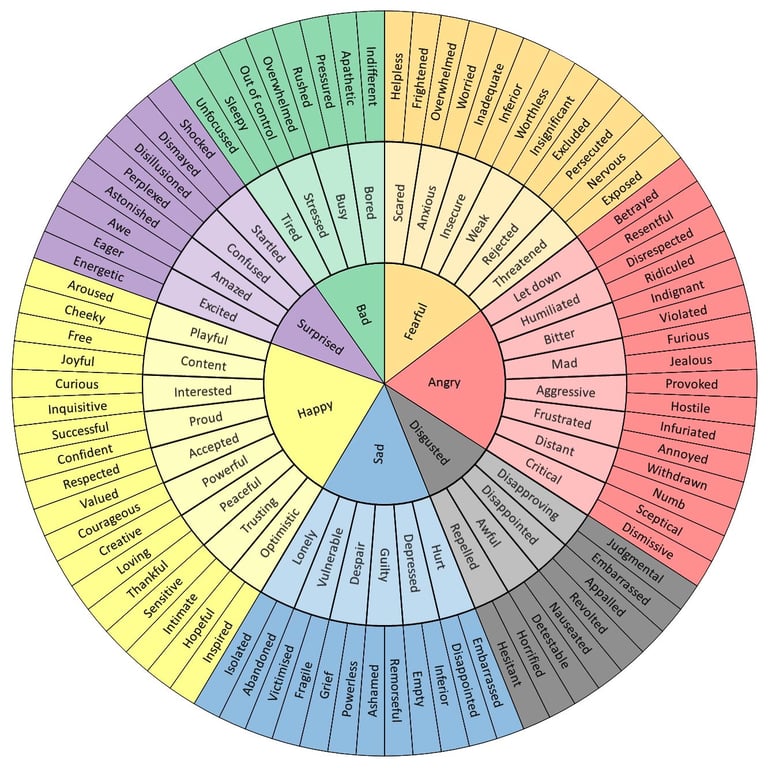Making Sense of Our Emotions: Five Steps to Feel Your Feelings
Do you intellectualize your feelings, have limited emotional vocabulary or have difficulty identifying or expressing yourself emotionally? If you identify with any of these then keep reading.
EMOTIONS
1/8/20255 min read


In a world that prioritizes logic, we often approach our emotions similarly. Instead of allowing ourselves to feel, allow it to run its course and focus on self-regulation, we may question why we feel a certain way. This is when our logical brain takes over, attempting to “solve” (or manage/suppress) our feelings but often interfering with our natural emotional process. Moreover, the more distressed we are, the more inhibited our logic brain is, which can make it difficult to use our logic brain in a meaningful manner. When we treat emotions as problems to be solved, we may lose touch with our authentic emotional experiences and connection to our true selves.
Emotions are meant to be felt and acknowledged, not necessarily "fixed." By allowing ourselves to experience emotions fully, we can better understand and regulate them, leading to a healthier emotional state and deeper self-awareness. Emotions are morally neutral; they are neither good nor bad. Let's view our emotions as internal experiences that are either more or less distressing. How we feel and respond to our emotions is often a personal experience. The more we allow ourselves to feel these emotions, the more we can tolerate them.
Emotions serve as cues from our bodies and brains to help us manage our daily lives, though they don't always get it right. Identifying our feelings helps us understand and manage them better. After all, we can't address what we're experiencing if we can't recognize it.
I often use the analogy of a burning house with clients who tend to intellectualize their feelings. When a house is on fire, it's not helpful to sit outside and analyze how it caught on fire. We must prioritize extinguishing the fire first. Similarly, when we experience distressing emotions, we need to tend to them, regardless of whether they are accurate to the situation. Remember, it is our truth but not necessarily the truth. Once we have time to process and make sense of our emotional experience we can then bring back our logic brain to help guide our behaviour.
Follow the steps below to support you on your journey to feeling your feelings and finding deeper self-understanding.
Happy feeling.


Step 1: Identify your Emotion(s)


Take stock of your “internal weather pattern” and ask yourself “what am I feeling” in this moment? More than often we may be experiencing multiple emotions simultaneously. It can be helpful to keep a record of your emotions and the physiological sensations that go with it either on your phone or by writing it down in a notebook.
An emotions wheel (like the one pictured) or having a list of emotions can help you with this process.
Identifying emotions as “bad” or “not good” are not emotions. Try to be more specific about what those “bad” feelings are.
Identify your emotions…now what?
Many people get stuck at this point because they don’t know what to do with their feelings once they’ve identified them. People who grew up in households where feelings were either not acknowledged or punished for displaying certain emotions often have difficulty with this. If you resonate with this
Step 2: Give Space & Validate
Our feelings may not always reflect the truth, but it is YOUR truth. Support yourself by giving space to feel your emotions without judgment. Sit with these emotions rather than pushing them away.
Remember that emotions are not permanent and will run their course if you let them. Think of emotions as a wave: they have a swell, a rolling, a build-up, a breaking point and a crashing descent. They differ in severity and length. The wave will not always be there. It will pass if we let it. Don't get swept up in the wave of emotion but rather learn to ride it until it comes to its natural conclusion.
I invite you to tell yourself phrases like:
“I feel….” (insert emotion)
“It’s okay that I feel X emotion”.
Step 3: Body Scan and Sensory Awareness
Take a moment and identify where these emotions come up in your body and notice the sensations that come with it.
Ask yourself where you are holding tension or tightness. Notice the quality of your breathing and how you are carrying yourself in this moment. Give yourself space to relieve tension in your body through movement, shaking or breathwork. If you have difficulty guiding yourself through this then find a guided clip on your favourite streaming platform.


Step 4: Express your Emotions
Decide how you’ll express yourself emotionally. There are many ways to do it so do not worry if what others have tried doesn’t work for you.
You can draw it out, talk it out, write a poem, play, cry, pray, dance, among many other things.








Step 5: Coping with distressing emotions
Emotions, especially distressing ones can be difficult but it is important to find coping mechanisms that will support you move through them with more ease. What will help you cope is individual to the person and the experience.
If you have trouble knowing where to start, write a list of activities you enjoy and have them readily available. Another idea is to create a coping toolbox that you have at hand when needed. Outsourcing coping mechanisms can be helpful in periods of high distress since the more distressed we are the more inhibited our logic brain is.
In the beginning, experimentation is key. Do not be discouraged if you try one thing and it does not work as what we need in the moment changes based on several factors such as the emotion experienced and the context in which you're experiencing it.




